Below the Surface in Amsterdam
When I went to see Below the Surface in Amsterdam, to be honest, I hadn’t done my research. Just a quick internet search, and I added it to my list of what I might see that day in Amsterdam. I expected a museum, a small one, in or near Rokin metro station, since that was its address.
Archeological finds from building the new metro line: that’s all I knew about it, and that’s what I got.
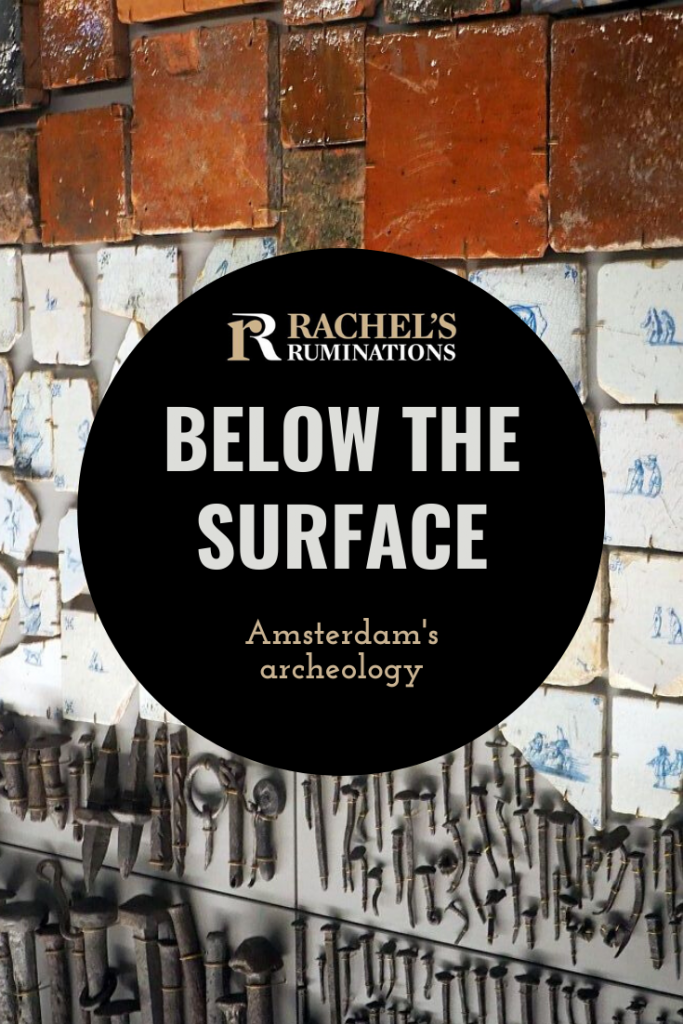
It turns out that Below the Surface is not a museum; it’s an exhibit of sorts. Or maybe I should call it a display.
Or perhaps I can describe it more accurately as an artwork, or rather two artworks. Mostly, though, it’s a website.
Disclosure: This post contains affiliate links. That means I’ll receive a small commission on anything you buy through clicking the links. This will not affect your price.
Building a new north/south metro line
First, some background. Starting in the late 1990s, the city of Amsterdam began to plan and then build a new metro line, going north and south of Amsterdam Central Station. The problem, as you can imagine, was the age and value of the buildings in central Amsterdam; the whole middle of the city inside Singelgracht is a UNESCO site, and the line had to pass straight through it.
The solution, then, was to build the tunnel following existing streets and old former waterways, including what used to be the Amstel River, and to bore the tunnel through rather than digging from street level. The designers of the new line set the depth of the tunnel far below the deepest wooden pilings supporting the historic buildings it passed.
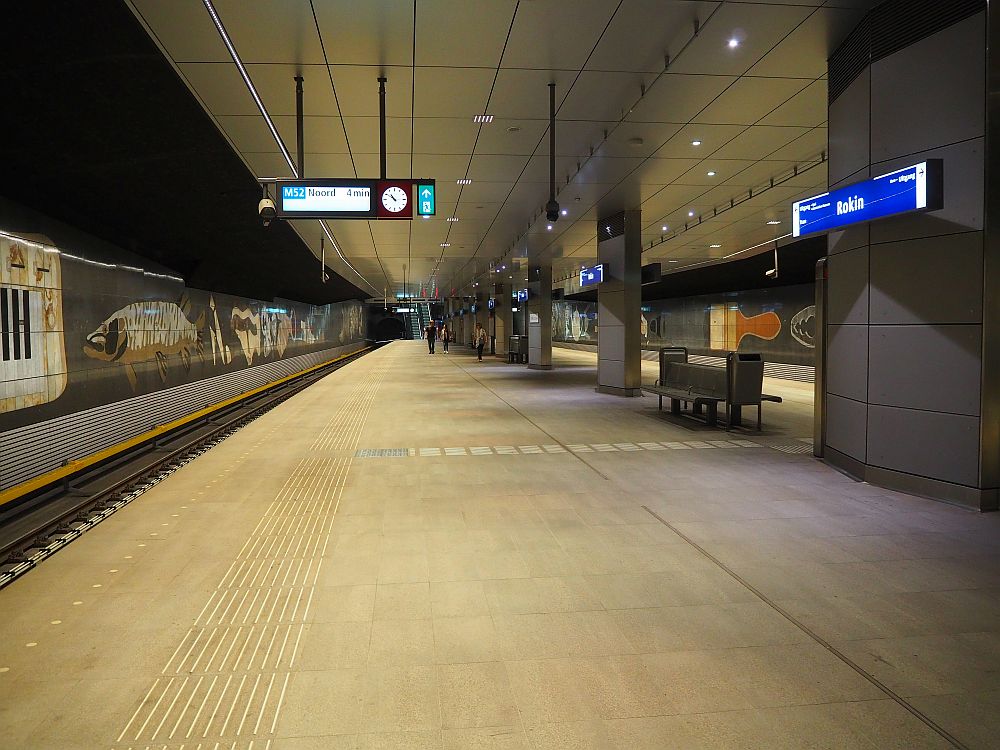
(Yes, those historic houses in Amsterdam are still supported, for the most part, on the original wooden pilings from centuries ago. Check out the Museum of the Canals to learn all about it.)
Construction started in 2003 and went on until 2018. The stations, unlike most of the tunnels, were built by digging down from the surface, and the archeologists focused their attention there. By digging down, they could see the layers of history and place whatever they found in its historical context. Four of the stations are located where rivers or streams used to flow.
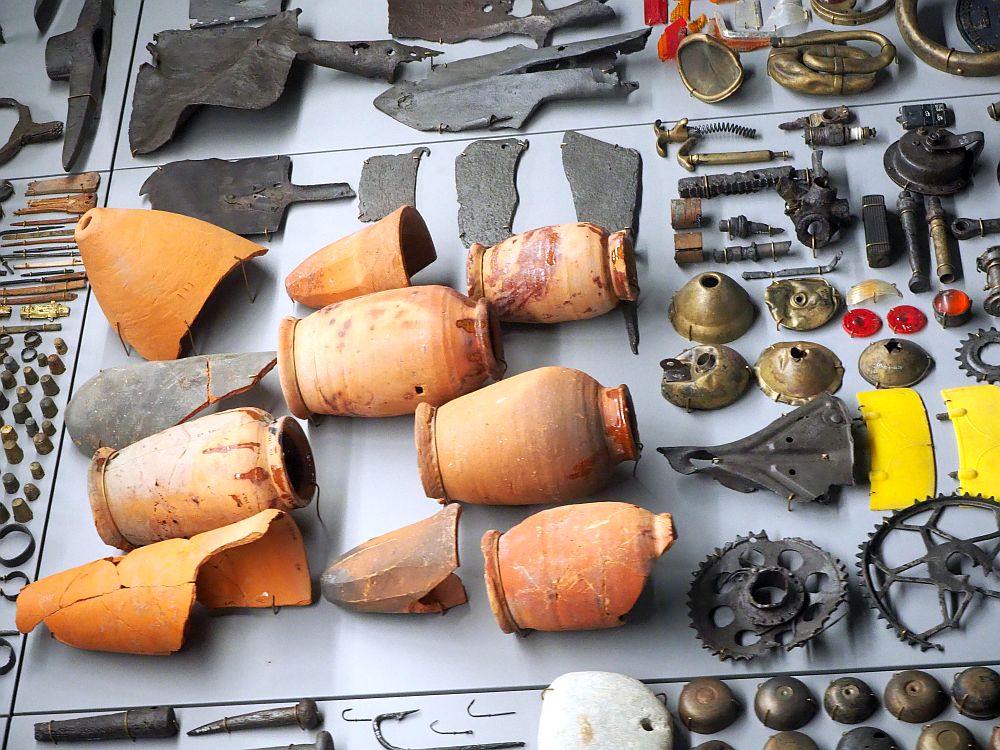
Archeology below the surface of Amsterdam
Not surprisingly, places where water once flowed are rich archeological sites. Think of all the junk that dredgers pull out of rivers and canals these days – more bicycles than anything else here in the Netherlands. Objects have landed in waterways, whether accidentally or intentionally, for centuries.
The excavations on the North-South metro line went further back than even the earliest human habitation, and examined how the river itself evolved.
Human presence – not necessarily settlement – started in the late Neolithic or early Bronze Age and extended through the Late Bronze to the Late Iron Age and through the region’s Roman period (up to 450 AD). It was, essentially, a peat bog, so it seems that people passed through but didn’t settle. Later the land was drained to allow farming, and at that point settlements appeared.
After a series of floods in the 12th century, the Amstel River became connected to other actively used waterways, making it a good place for a trading settlement. The objects that form the exhibit called “Below the Surface” are basically debris, dating from the 13th to the 19th centuries, that fell or was discarded into the Amstel.
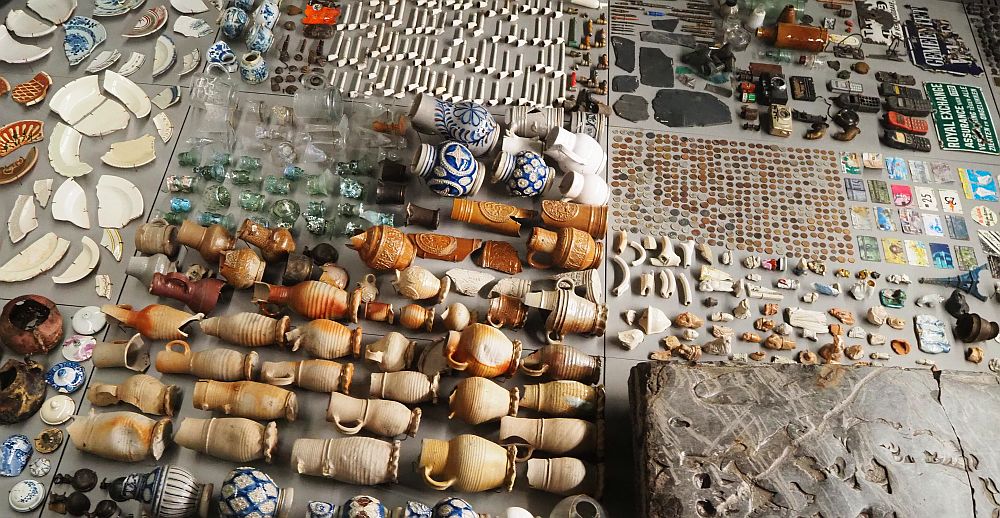
Archeological sites in Amsterdam
Both Damrak and Rokin metro stations are where the most items were excavated, both located where the Amstel River used to flow.
Damrak metro station’s site is where an important bridge once stood connecting the two banks of the river. Originally wood, then later stone and, later still, brick, it was an important harbor entrance. Shipping-related objects would be found there, as well as commercial objects since all sorts of economic activity happened around the crossing. In the 16th century this bridge was part of the city’s defense, so military debris would end up in the water as well.
On the other hand, today’s Rokin metro station stands where once an inland harbor teemed with boats coming and going, carrying merchandise. With all that economic activity and the city crowding around the harbor, it’s not hard to imagine the kinds of waste that would end up in the water.
Planning a trip to Amsterdam? Book your hotel here or use the map below:
Excavated objects: “stuff”
In total, archeologists working on the north-south line recorded 697,235 finds, mostly from Damrak and Rokin, but also including fewer than 2000 pieces from other sites. The numbers include each individual fragment of broken pieces, so perhaps a more realistic indicator is the number of “records,” where pieces of a single object put together count as one: 134,282. Still pretty impressive, isn’t it?
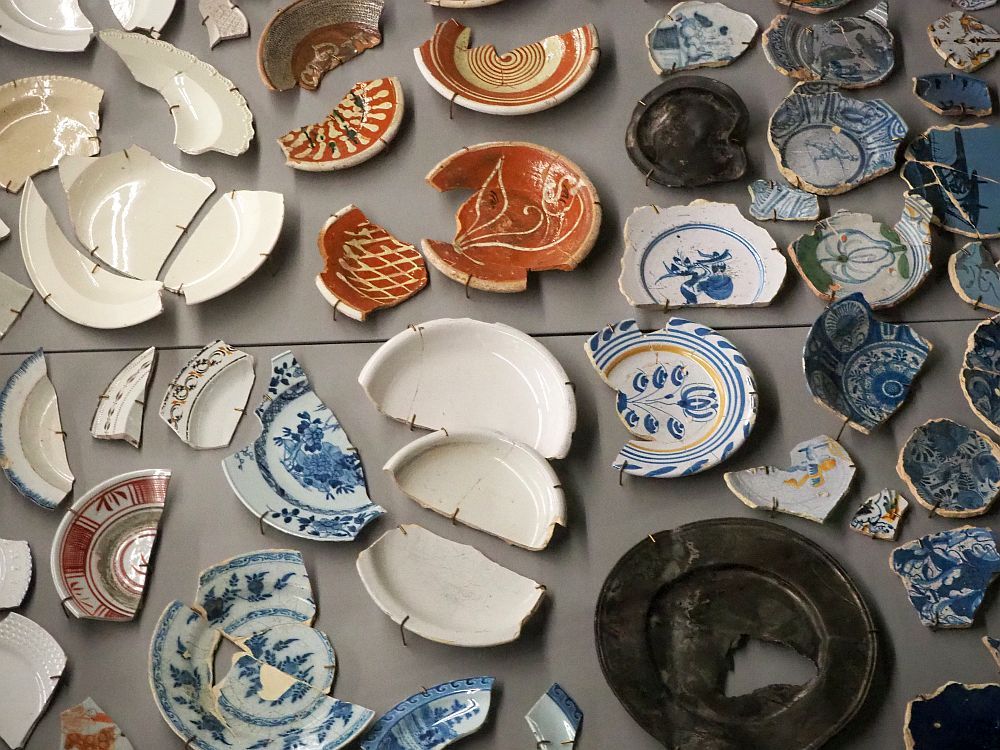
In order of frequency, the most common object was ceramic, then bone, metal, leather, pipe clay, glass and building ceramics. Most of Damrak’s objects date to 1450-1600 while most of Rokin’s date to 1650-1875.
The project’s website (where I got most of the information for this article) goes into far more detail about all of the processes archeologists used to draw conclusions from what they found and where they found it.
The website also shows photographs of the objects. All are carefully catalogued – the catalogue is called “Stuff” – by function, time and space. They are arranged according to city functions like “building and structures,” “interiors and accessories,” “craft and industry” and so on. There are 10 categories in all, shown in 11,279 pictures.
Make sure to check out my other articles about museums and other sights in Amsterdam!
On the website you can search the catalogue in a variety of ways, and you can make your own display, choosing objects to illustrate your own interests. Or you can click on “object stories” and get more information on particular objects and their context.
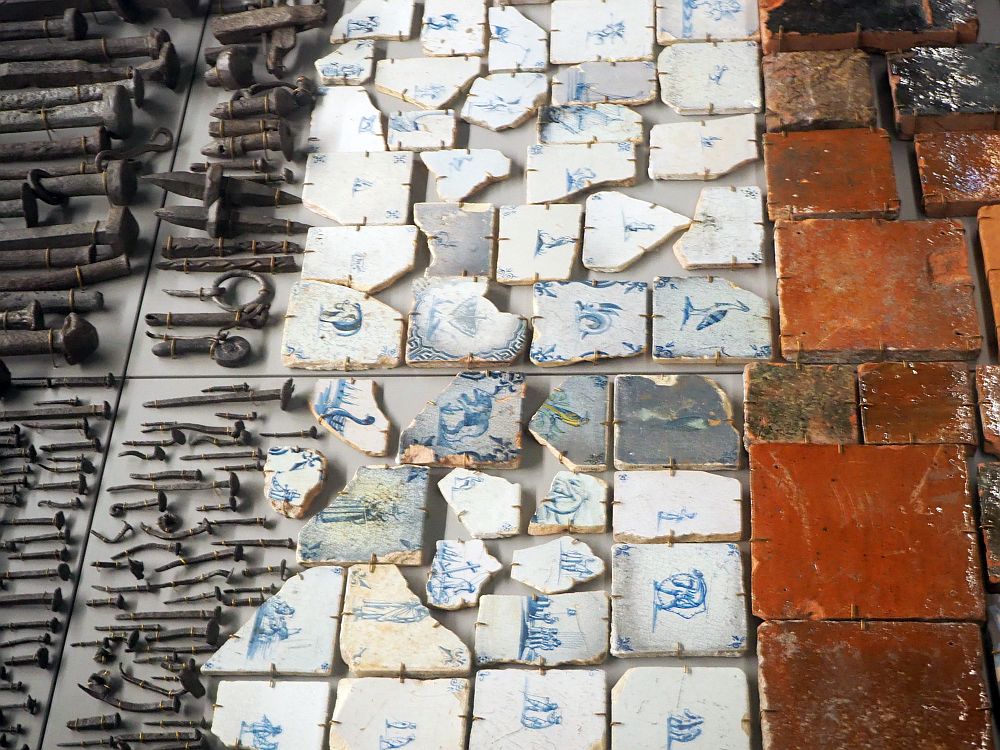
The exhibit / artwork
Designed by Daniel Dewar and Gregory Gicquel, the artwork in the new Rokin Station incorporates 9,500 of the archeological objects as well as large mosaics on the walls of the station that reflect themes deriving from the objects.
The objects are displayed in two long cases, on a slant, extending between the up and down escalators at the north and south ends of the station. One is 12 meters long and the other is 14 meters long.
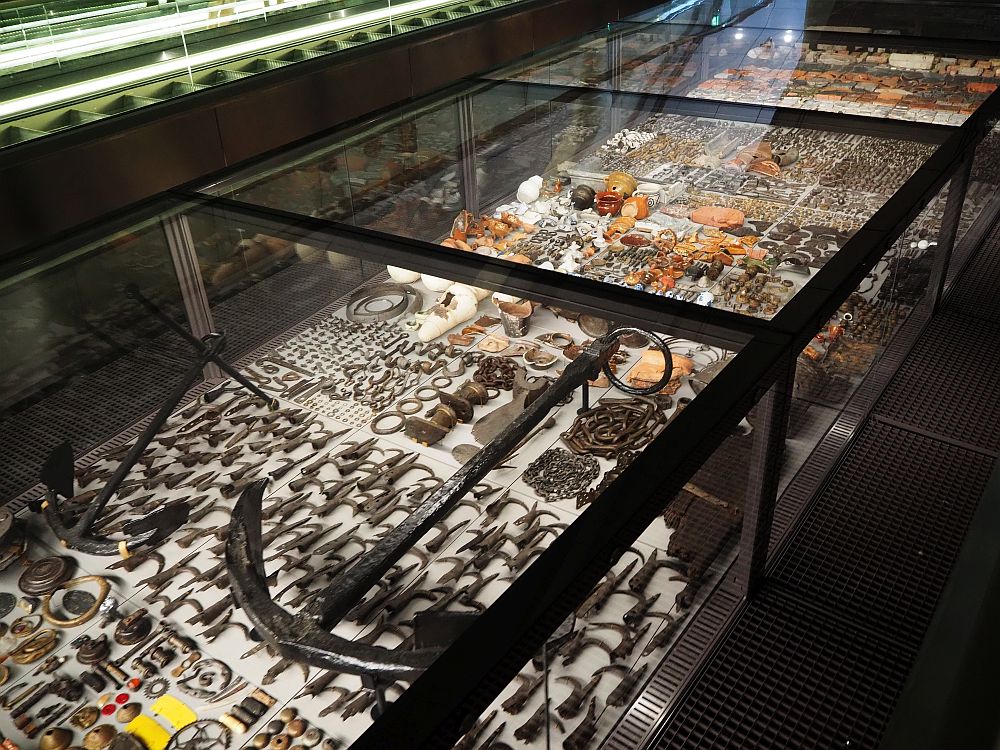
Closely placed in the cases, the objects are grouped by function. The display gives a fleeting impression rather than an opportunity to study individual pieces. There are no labels or informational signs. For detail, you’d have to visit the website’s page about the Rokin Station exhibit. There, you can view each of the cases as one image, zoom in and click on an individual object for more detail.
The escalator can’t be slowed or stopped, and no other way to peer in at the objects in real life is available. The result is more of a glimpse of quantity – Wow, what a lot of old objects! – rather than an understanding of what the objects actually are.
Yet, as you pass – and I have to admit I went up and down a number of times – some objects stand out: bones, pottery, Delftware tiles, a large ship’s anchor, and lots of iron nails.
I ruminated a bit as I traveled up and down the escalators:
- I wondered whether the person who is looking determines which objects draw that fleeting moment of attention, or whether most people’s eyes go to the same ones.
- Would the security cameras lead to my being flagged up as a suspicious character when I kept going up and down the escalators?
- I hoped that my pictures would come out well, since I was moving as I took them.
Below the Surface is not a museum. It’s a teaser, it seems to me, for the associated website. That doesn’t make it any less valuable or worth seeing.
How to get to Below the Surface at Rokin Station
There are a number of ways to get to the Rokin Metro Station. It’s quite central, so from many of the tourist hotels it’s within walking distance. However, the two displays are inside, after the ticket barrier.
The North-South metro line is number 52.
- If you have the Iamsterdam City Card, you’re all set. Besides all the museum admissions covered by the card, it includes transportation, so it won’t cost you anything to get into Rokin.
- If you don’t have the Iamsterdam City Card, you can buy a GVB dagkaart – a day ticket to the metro, trams and buses in Amsterdam and several nearby towns – for €9.00 from a machine in any metro station.
- If you have an OV-card (a regular transportation card that residents use for all forms of transportation), you pay by distance. I paid €1.15 on my OV-card to travel the one stop from Amsterdam Central to Rokin.
- You could also just buy a one-hour card for €3.20.
Generally the metro stations are open 6:00-24:00.
My travel recommendations
Planning travel
- Skyscanner is where I always start my flight searches.
- Booking.com is the company I use most for finding accommodations. If you prefer, Expedia offers more or less the same.
- Discover Cars offers an easy way to compare prices from all of the major car-rental companies in one place.
- Use Viator or GetYourGuide to find walking tours, day tours, airport pickups, city cards, tickets and whatever else you need at your destination.
- Bookmundi is great when you’re looking for a longer tour of a few days to a few weeks, private or with a group, pretty much anywhere in the world. Lots of different tour companies list their tours here, so you can comparison shop.
- GetTransfer is the place to book your airport-to-hotel transfers (and vice-versa). It’s so reassuring to have this all set up and paid for ahead of time, rather than having to make decisions after a long, tiring flight!
- Buy a GoCity Pass when you’re planning to do a lot of sightseeing on a city trip. It can save you a lot on admissions to museums and other attractions in big cities like New York and Amsterdam.
Other travel-related items
- It’s really awkward to have to rely on WIFI when you travel overseas. I’ve tried several e-sim cards, and GigSky’s e-sim was the one that was easiest to activate and use. You buy it through their app and activate it when you need it. Use the code RACHEL10 to get a 10% discount!
- Another option I just recently tried for the first time is a portable wifi modem by WifiCandy. It supports up to 8 devices and you just carry it along in your pocket or bag! If you’re traveling with a family or group, it might end up cheaper to use than an e-sim. Use the code RACHELSRUMINATIONS for a 10% discount.
- I’m a fan of SCOTTeVEST’s jackets and vests because when I wear one, I don’t have to carry a handbag. I feel like all my stuff is safer when I travel because it’s in inside pockets close to my body.
- I use ExpressVPN on my phone and laptop when I travel. It keeps me safe from hackers when I use public or hotel wifi.



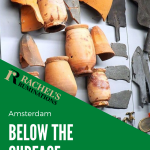
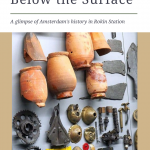
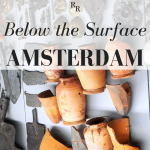
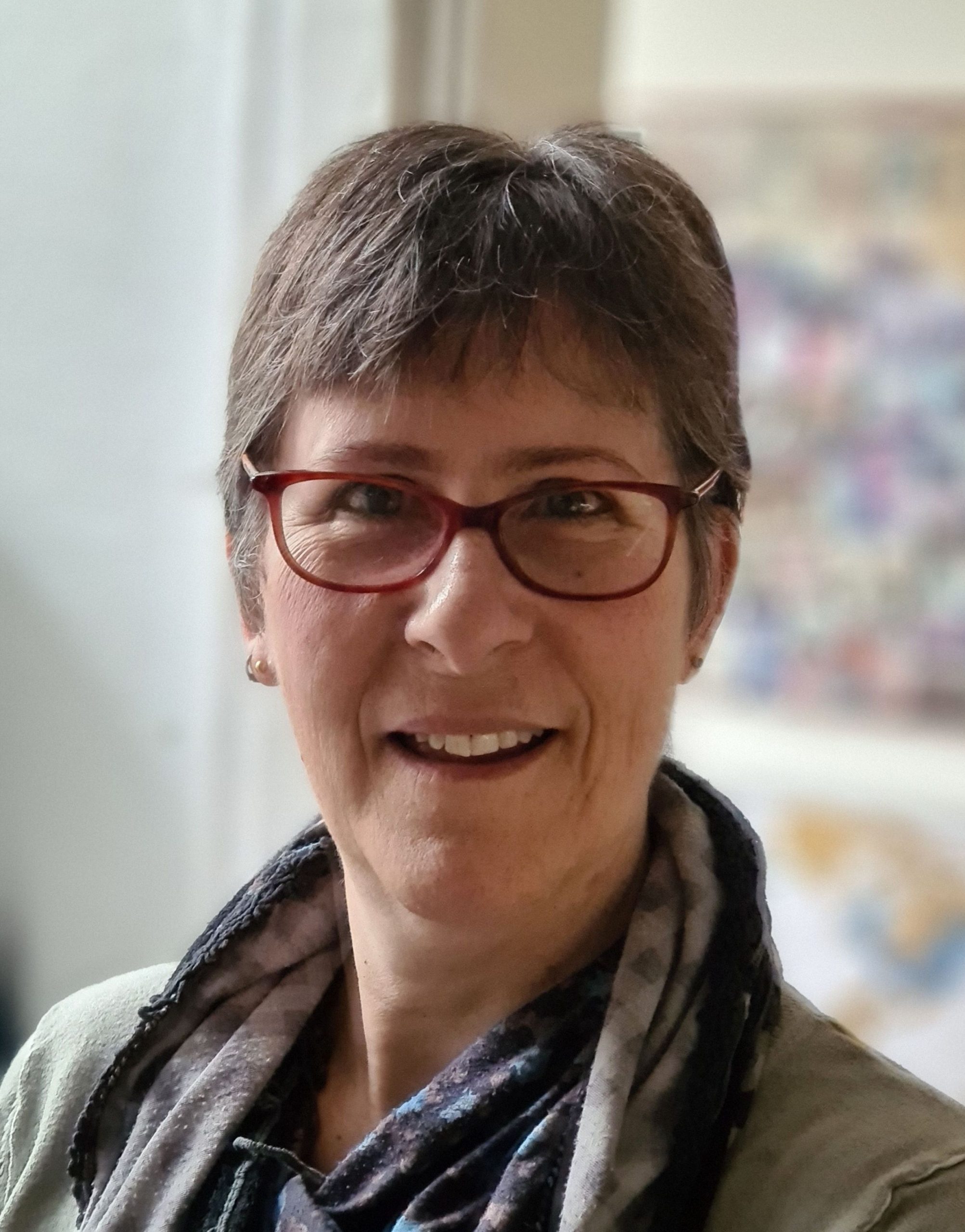
What an amazing collection to unearth below the surface of Amsterdam. We can only imagine how tedious the task of cleaning and reassembling the pieces must have been. Thanks for sharing this peek inside and intriguing us to visit for ourselves.
It took them years! And they were only focusing on a few places. Imagine how much more there must be to discover along the rest of the Amstel’s old route!
I’ve been to Amsterdam several times and I guess I’ve never imagined there was much archeology going on. Too much water, I thought. I always like looking at the evidence of what a city once was and am fascinated by the “stuff” one finds by digging. (Why do cities grow my piling one layer upon another?) They just do, I guess.
Seems like a perfect example of ‘one man’s garbage is another man’s treasure’. Given the amount of items/artifacts on display, I think I’d prefer to spend time with descriptions on the displays rather than on a website. But interesting just the same.
So would I. It’s just somehow “realer” in person than on-line.
What a fascinating place – a great way to discover some of the history of the city. And I love the idea of making the exhibits into a sort of artwork!
Thanks for taking us readers on what felt like an archaeological dig. Having been in the station, I found it especially fascinating!
I am so impressed with this display of history. Will make a note of this station and the next time we have a stopover there will definitely go visit!